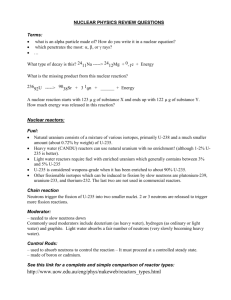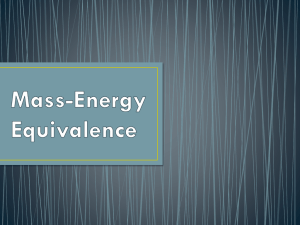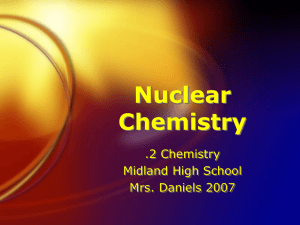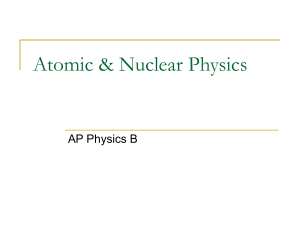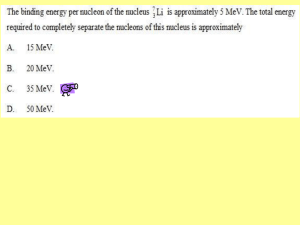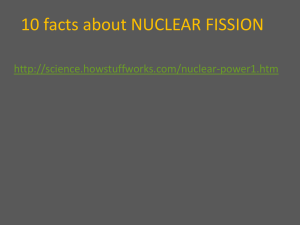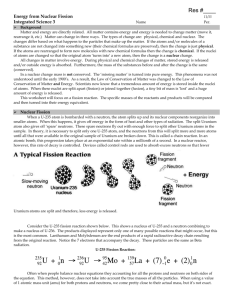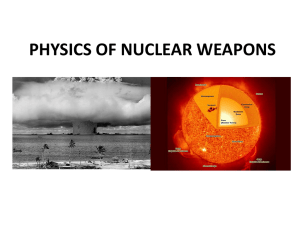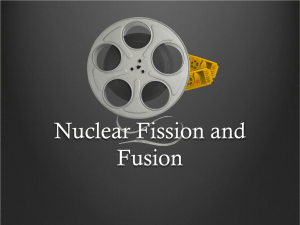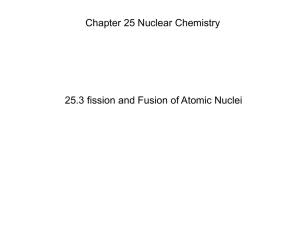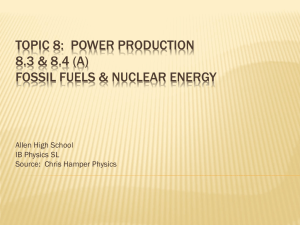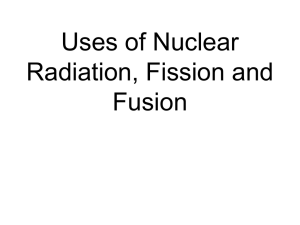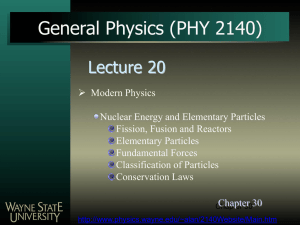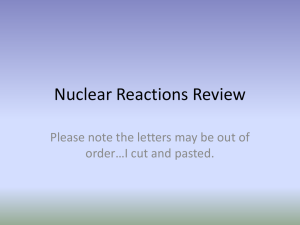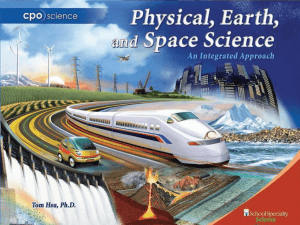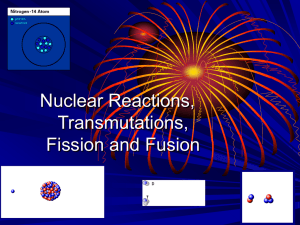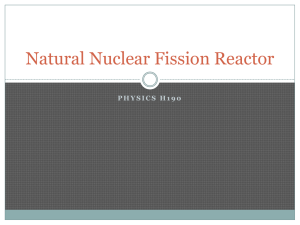NUCLEAR CHEMISTRY
advertisement
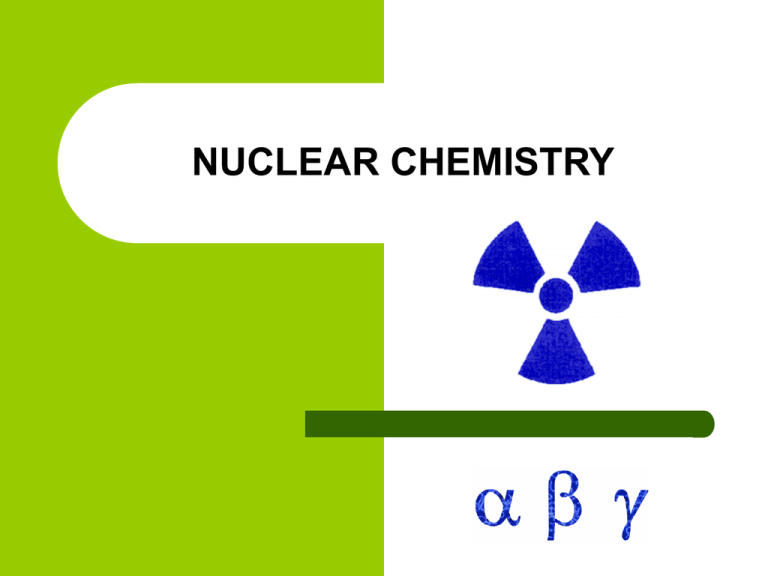
NUCLEAR CHEMISTRY FYI: Historical Perspective Henri Becquerel 1896 - Discovers natural radioactivity FYI: Historical Perspective Marie Sklodowska, Polish chemist marries Pierre Curie, French physicist Marie died from leukemia caused by her exposure to radiation Pierre was killed while crossing the street when he was hit by a vegetable wagon. FYI: Historical Perspective Earnest Rutherford 1899 – Discovers alpha, beta and gamma radiation Nuclear Reactions Involve changes in the composition of nuclei Accompanied by the release of tremendous amounts of energy Nuclear Fission The splitting of a heavy nucleus into lighter nuclei Nuclear Fusion The combination of light nuclei to produce a heavier nucleus Nuclides Different atomic forms of all elements Most small nuclides have equal # of protons and neutrons Some nuclides have “magic #’s” of protons and neutrons and are especially stable The neutron-to-proton ratio determines the stability of the nucleus For low atomic #’s: – Equal #’s of protons and neutrons Above atomic #20: – More neutrons than protons Nuclei whose neutron-to-proton ratio is unstable undergo radioactive decay by emitting 1 or more particles and/or electromagnetic rays: Nuclei whose neutron-to-proton ratio is unstable undergo radioactive decay by emitting 1 or more particles and/or electromagnetic rays: Type/ symbol Alpha 4 Identity Mass Charge Penetration (amu) or 2 He helium nucleus 4.0026 2+ low or -01e electron 0.00055 1- low-med 0 high Proton 1p or 1H 1 1 high energy 0 radiation proton, 1.0073 H nucleus 1+ low-med Neutron neutron 0 very high Beta Gamma 0 0 1 0 n 1.0087 Comparing penetrating ability… Alpha Particle Decay Example 1: Radium-226 transmutates by alpha decay. Write the nuclear equation that represents this process. 226 88 Ra 222 86 Rn or 226 88 Ra 222 86 Rn He 4 2 + + Beta Particle Decay Example 2: Write the nuclear equation for the beta-decay of boron-12. 12 5 B C 12 6 or 12 5 B C e 12 6 0 1 Gamma Radiation Example 3: Write the nuclear equation representing gamma radiation given off by the unstable radionuclide cobalt-60. 60 27 Co Co 60 27 Nuclear Fission & Fusion FISSION: a heavy nucleus splits into 2 lighter nuclei some elements undergo fission spontaneously some elements can be induced to undergo fission when bombarded with other particles (e.g. neutrons) FUSION: 2 nuclei combine to form a heavier nucleus the sun is a tremendous fusion reaction; the major fusion reaction in the sun is thought to be: H H He n energy! 2 1 3 1 4 2 1 0 both fission & fusion release large amounts of energy (fusion more than fission) The Atomic Bomb (FISSION) when the nucleus of U-235 splits, 2 isotopes are formed, plus neutrons are emitted these neutrons collide with other U-235 atoms, causing them to undergo fission; they release neutrons, and so on… The result - CHAIN REACTION!! FISSION CHAIN REACTION!!! The Atomic Bomb (FISSION) The Atomic Bomb (FISSION) CRITICAL MASS The minimum mass of fissionable material that must be used to sustain a chain reaction One type of bomb… Little Boy: U-235 (Hiroshima) Fat Man: Pu-239 (Nagasaki) subcritical mass of U-235 subcritical mass of U-235 TNT (dynamite) Nuclear Reactors (controlled FISSION) Nuclear Reactors (FISSION) use subcritical masses of fissionable material CORE: contains fuel pins made of U-235; interspersed among the pins are control rods control rods: absorb neutrons – pull rods out of core: fission increases – push rods back into the core: fission decreases Safety feature: if power is lost, rods will automatically fall into the core and shut the reaction down. Nuclear Reactors (FISSION) “The energy produced by breaking down the atom is a very poor kind of thing. Anyone who expects a source of power from the transformation of these atoms is talking moonshine.” Ernest Rutherford Nuclear Reactors (FISSION) Nuclear Power Plants Nuclear Power Plants Nuclear Power Plants TO GENERATE ELECTRICITY: 1) 2) 3) 4) Fission heats up water in vessel and heat is carried away. This heat is used to heat up water in a second system, which turns into steam. Steam turns turbine of a generator. Generator makes electricity. PROS OF NUCLEAR ENERGY: no air pollution enormous amt. of energy released alternative to using our rapidly decreasing fossil fuels CONS OF NUCLEAR ENERGY containers for waste products may erode or break thermal pollution (heated water returned to rivers, etc.) potential theft of fuel (Pu-239) for use in weapons Controlled Nuclear FUSION PROS: – – – – A very abundant supply of energy world wide. Environmentally clean No creation of weapon materials No chance of runaway reactions leading to accidents CONS: – It doesn’t work; at least not yet… Nuclear Fusion "Every time you look up at the sky, every one of those points of light is a reminder that fusion power is extractable from hydrogen and other light elements, and it is an everyday reality throughout the Milky Way Galaxy." Carl Sagan, Spitzer Lecture, October 1991 Nuclear Fusion Obstacles… – – – – HOT – plasma at least 100 million C High density plasma Containment of plasma Confinement time Rates of Decay & Half Life Radionuclides have different stabilities and decay at different rates. Integrated Rate Equation A log A kt 2.303 where… A = the amt. of decaying sample remaining at some time, t Ao= the amt. of sample present at the beginning k = rate constant; different for each radionuclide t = time Integrated Rate Equation OR… kt N log N 2.303 where… N = # of disintegrations per unit of time; relative activity No= original activity HALF-LIFE= the amount of time required for half of the original sample to decay Half Life 120 100 Amount 80 60 40 20 0 0 5 10 Time 15 20 HALF-LIFE= the amount of time required for half of the original sample to decay Daughter 250 Time 200 150 Parent 100 50 0 0 5 10 Amount 15 20 HALF-LIFE Half-life = the amount of time required for half of the original sample to decay ln 2 0.693 t1 2 k k 0.693 k t1 2 Example: Cobalt-60 decays with the emission of beta particles and gamma rays, with a half-life of 5.27 years. How much of a 3.42 g of cobalt-60 remains after 30.0 years? 0.693 k 0.1 31 5yr-1 5.27 years A log A kt 2.303 -1 3.42g (0.1 31 5yr )(30.0yrs) log 2.303 A 3.42g log 1.71 3 A How do you solve for A??? Take the ANTILOG x (10 ) of both sides. Example: Cobalt-60 decays with the emission of beta particles and gamma rays, with a half-life of 5.27 years. How much of a 3.42 g of cobalt-60 remains after 30.0 years? 3.42g antiloglog antilog1.713 OR A 3.42g 1 01.713 A 3.42g 51.6 A 3.42g A 51.6 A 0.0662g 3.42g log A 10 101.713 Uses of Radionuclides Radiocarbon dating: the ages of specimens of organic origin can be estimated by measuring the amount of cabon-14 in a sample. Example: A piece of wood taken from a cave dwelling in New Mexico is found to have a carbon-14 activity (per gram of carbon) only 0.636 times that of wood today. Estimate the age of the wood. (The half-life of carbon-14 is 5730 years.) 0.693 0.00012094 yr-1 k 5730 years kt N log N 2.303 N log .636N N .636N (0.0001 209 4yr-1 )(t) 2.303 1 -5 -1 log (5.25x10 yr )(t) .636 Example: A piece of wood taken from a cave dwelling in New Mexico is found to have a carbon-14 activity (per gram of carbon) only 0.636 times that of wood today. Estimate the age of the wood. (The half-life of carbon-14 is 5730 years.) 1 -5 -1 log (5.25x10 yr )(t) .636 0.19654 (5.25x10-5 yr-1)(t) t=3744 yrs = 3740 yrs Uses of Radionuclides ***NOTE: Objects older than 50,000 years have too little activity to be dated accurately using carbon dating; instead the following methods are used: – – Potassium-40 decays to argon-40: half-life = 1.3 x 109 years Uranium-238 decays to lead-206: half-life = 4.51 x 109 years Example: A sample of uranium ore is found to contain 4.64 mg of uranium-238 and 1.22 mg of lead-206. Estimate the age of the ore. 238 g/mol U 1.22 mg Pb x 1.41 mg U - 238have decayed 206 g/mol Pb A 1.41 mg 4.64mg 6.05mg U k 0.693 4.51x 1 09 yrs 1.54x 10-10 yr-1 Example: A sample of uranium ore is found to contain 4.64 mg of uranium-238 and 1.22 mg of lead-206. Estimate the age of the ore. A log A kt 2.303 6.05mg (1 .54 1 0-10 yr-1 )(t) log 4 . 64 mg 2.303 t 1.73 billion years

